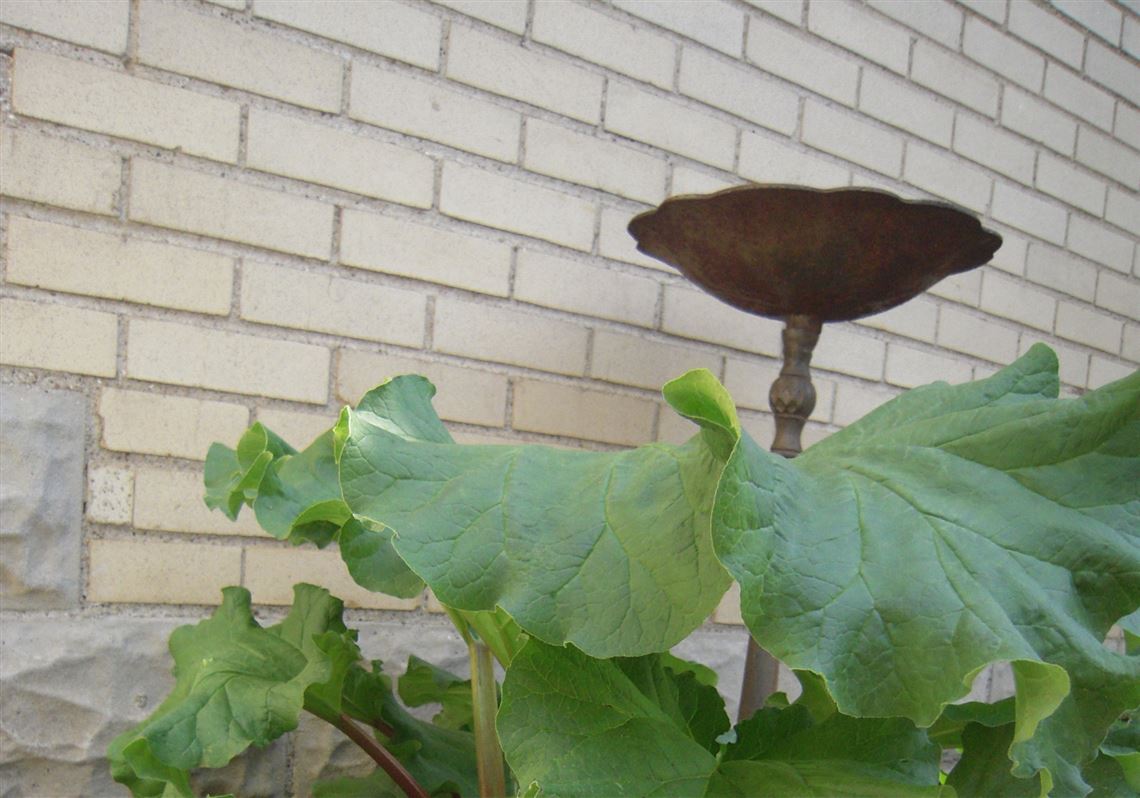With rhubarb, be patient and you’ll be rewarded

Rhubarb (Rheum rhabarbarum) is an ideal edible plant for the home garden. The deliciously tart stalks can be expensive at the grocery store, but when grown as a herbaceous perennial, rhubarb is inexpensive, needs very little care, is bothered by few pests and diseases and is very long-lived.
Although rhubarb is technically a vegetable, it is legally a fruit and is treated as a fruit in the kitchen. Rhubarb sauce, rhubarb pie, rhubarb crisp, rhubarb-onion chutney, strawberry-rhubarb preserves and bluebarb jam have all been constants on my table since childhood. I love rhubarb not only for its flavor but for its beauty in the garden. It is a large bold plant with beautiful, robust, deep green, textured leaves that sit atop colorful long petioles or stalks. It deserves a place in more perennial flower beds.
Cultivars vary in stalk color from pink to red to speckled to green. The flavor is fairly consistent among cultivars and there is no correlation between tartness and stalk color. Red stalk cultivars include ‘Canada Red,’ ‘Crimson Red,’ ‘McDonald’ and ‘Valentine.’ Red cultivars may produce thinner and fewer stalks. ‘Victoria,’ a robust green-stalked variety, is a very reliable performer with thicker stalks.
Rhubarb divisions and crowns can be found at local garden centers and by mail order. It can be grown from seed but takes a long time, and the seed may not be reliably similar to the parent.
Spring or early fall are the best times to plant. Rhubarb requires a site in full sun with well-drained, fertile soil amended with organic matter such as leaf mold, compost or well-rotted manure. It is not sensitive to the pH of the soil. The area around the site should be weed-free. Provide plenty of space, about 3 square feet. With our clay soil, you may need to hill up the area for drainage or plant in a raised bed.
Once it’s planted, have a little patience. Harvest nothing the first year and sparingly the second year. This delay will allow the large leaves to provide sufficient energy for crown and root development. From the third year on you may start harvesting in the spring to early summer, but remove no more than half of the plant at one time. This cool-season crop will naturally slow down during the hotter days of summer but resume growth as cooler temperatures return. You may continue to harvest, but back off when the stalks get thinner as this is a sign that the reserves in the crown are depleted.
Rhubarb requires little maintenance. Water it deeply during extended dry periods. Fertilizer helps with growth and large yields. In early spring, apply around the perimeter of the plant either a half-cup of 5-10-10 all-purpose fertilizer (and work it into the soil) or a 2- to 3-inch layer of well-rotted manure. Mulching suppresses weeds and conserves soil moisture. If a flower/seed stalk appears, remove it by pulling or cutting it off at the base. Otherwise, it will reduce plant vigor and stalk formation. After the ground is frozen in the late fall, apply 2 to 3 inches of straw mulch.
Divide this perennial every seven to 10 years as you notice it becoming less productive, with thinner fruit stalks and perhaps more seed stalks. In early spring, as soon as the soil can be worked, dig up the entire plant and lift it from the ground. Section the clump into divisions that contain at least one or two buds and a good root system. Inspect the center of the clump for indications of root rot as this crowded area may need to be discarded. Plant each divided section in a prepared hole so that the buds are upright and 1½ to 2 inches below the surface. Firm the soil around the plant but don’t press directly on the sensitive buds themselves.
Very few pests bother rhubarb. Deer don’t touch it. Rhubarb curculio may cause minor damage by puncturing the stalk. This ¾-inch-long rusty snout beetle lays its eggs in curly dock stems. To control this pest, eliminate curly dock from your garden in July, after the beetles have laid their eggs. Another pest, rhubarb stalk borer, overwinters in the egg stage on grassy weeds. Eliminate grassy weeds from the area.
The only other potential issue is phytophthora crown or “root rot.” Control this culturally by planting only disease-free divisions in a well-drained sunny site with good air circulation.
Wait until your stalks are 10 to 15 inches long, then harvest by holding the stalk firmly and pulling with a slight twist. Do not harvest by cutting the stalks as this will allow for disease to enter the plant crown. Take your knife to the garden and cut off the leaf as well as the base of the stalk where it attaches to the crown of the plant. The leaves are poisonous with toxic levels of oxalic acid but can be safely composted.
Fresh rhubarb can be stored in a plastic bag in the refrigerator for up to two weeks. For longer storage it can be easily frozen or canned. To freeze: wash, trim and cut into appropriate sizes for later use. Pack a measured amount tightly into a freezer-safe container; leave appropriate headspace, label, seal and freeze. I store 2- and 3-cup batches based on the amount needed in future recipes. To can, follow only research-based methods and recipes.
However you choose to use the stalks in the kitchen, rhubarb is sure to provide beauty in your garden for years to come.
This article was first published in the Pittsburgh Post-Gazette on May 16th, 2014.